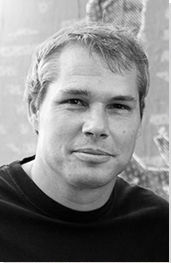Summary of Shepard Fairey
One of the most influential and best-known Street Artists, Shepard Fairey is a key figure in the creation and development of modern urban art. Emerging from the skateboarding scene and rising to prominence in the early 1990s, his street campaigns are wide-reaching and prolific, with some sparking international cultural movements. As Banksy noted, "If Shepard Fairey comes to your town, every single graffiti writer gets uptight...I am absolutely positive he has made more reaches [street art interventions] than any graffiti writer in history ever has done or ever will. And that means he's won". Fairey's posters, stickers, and murals are a combination of parody, subversion, and dissent and seek to disrupt the boundaries between traditional and commercial art, asking questions about notions of public space and expected behaviors. He has also made his mark as a graphic designer in both political and commercial spheres, with his work utilized in a number of very high-profile campaigns.
Accomplishments
- Fairey is a dedicated political and environmental activist and many of his works advocate for awareness and change across a wide spectrum of areas from gun control to climate change. He provides many of his poster designs for free on his website and through other media so they can be used as a tool by protesters and other activists to challenge the status quo.
- Much of Fairey's Street Art is intended to stimulate curiosity and make people think about their surroundings, placing their own interpretation on the work based on its context and their personal thoughts and experiences. This in turn helps to initiate conversations about social, political, and legal constructs.
- Fairey often fuses appropriated commercial images, in the manner of Pop Art, with strong geometric lines and shapes which are reminiscent of Russian Constructivism. In doing so, he draws parallels between advertising and propaganda, encouraging viewers to question the role that marketing plays in their conscious and unconscious decisions.
The Life of Shepard Fairey

Apartments in this Berlin building are known to fetch higher prices, because Fairey has made these outer walls into colorful artworks.
Important Art by Shepard Fairey

Andre The Giant has a Posse
Fairey created this sticker, which shows the face of French wrestler André René Roussimoff (perhaps best known for his role as Fezzik in The Princess Bride), while showing a friend how to make stencils. He spotted the image in a newspaper, created a stencil and added the words "has a posse" as a nod to hip hop culture. He then made a few more "as a joke" and used his fake ID to get into clubs where he would post them, as well as placing them on outside street signs.
He described the stickers as a "skateboarding chain letter" which were just supposed to be seen by the people within his community. They started to gain wider attention, however, with a local paper appealing to find out who the artist was and what was behind them. Fairey said: "I noticed that putting stickers in a few places that were just supposed to be noticed by my friends was actually catching the attention of a lot of people and that started to raise issues of the control of the public space and image absorption...I quickly realized that disrupting the usual semiotics of consumption and control of public space was actually really powerful and provocative." Fairey took the campaign one step further by posting an enlarged version of the design over the head of politician Buddy Cianci in a local election billboard. Fairey added: "The media took hold and everyone read into it. Only a few people knew it wasn't a commentary but it made me realize the power of scale. That really impacted the conversation." The design has now become so iconic, that it is regularly manipulated and parodied by others.
This experiment made Shepard examine the public space, and how people view and absorb what is put in it by commercial bodies and governments. Based on this experience, Fairey wrote a manifesto the following year that reviewed sticker campaigns as an experiment in phenomenology (the philosophical study of the structures of experience and consciousness). This manifesto was later updated in line with his new campaigns. In the manifesto, he noted that "The first aim of phenomenology is to reawaken a sense of wonder about one's environment...to stimulate curiosity and bring people to question both the sticker and their relationship with their surroundings... The sticker has no meaning but exists only to cause people to react, to contemplate and search for meaning in the sticker."
Sticker
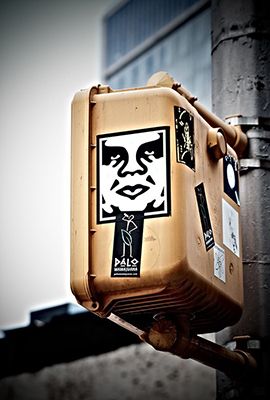
Obey Giant
Based on his initial success, Fairey adapted his first sticker to create his Obey campaign, featuring a stylized and simplified image of Andre The Giant's face. This was disseminated as a sticker, but also painted onto buildings through the use of a stencil. Fairey printed the word "Obey" beneath the image, and this word informed his brand both commercially (OBEY Clothing) and artistically (Obey Giant).
Fairey posted the Obey Giant image in cities across the world in a move that he thought "democratized art". He wanted to make art accessible and show that there was room in the public space for more than advertising and government signage. As Art writer Alex Rayner notes: "What sets Fairey apart from other graffiti fanatics is the scale of his Giant campaign. The Andre image predates most other street-poster graffiti artists and Giant heads have been plastered up in Japan, Russia, Italy and Paris, as well as numerous sites throughout the UK and the US. Even British stencil artist, Banksy, cites Fairey as an influence."
Inspired by the dissenting music of the Dead Kennedys, and the fiction of Ray Bradbury and George Orwell, Fairey wanted to question the "homogeny, hegemony, conformity and systems of oppression" within the US. He was struck by the word "Obey" and how people follow the path of least resistance. He said: "People are told 'This is the right way to do it, these are expectations, these are the rules'...But when 'Obey' confronts you it makes people question: 'What makes you the authority? Do I want that? Do I want to buy that?'"
With Obey Giant, graphic artist and designer Barbara Kruger's influence is clear in both the color scheme and the Futura typeface. Fairey wrote: "Kruger's style was eye catching and seemed to universally say 'pay attention and take this seriously'". He has described the image as his own propaganda, and the style also looks back to Russian Constructivism. Art professor Dr. Hwa Young Caruso notes that: "Fairey's Obey series stands out as an example of the authoritarian influence of propaganda poster art. In Benito Mussolini's fascist Italy the credo of the Fascist party was 'believe, obey, fight'. Fairey's posters combine elements of world history, blending fascist symbols with the communist propaganda art of the former Soviet Union, the People's Republic of China, Vietnam, and the imperialistic goals of modern Japan."
Stencil/Sticker
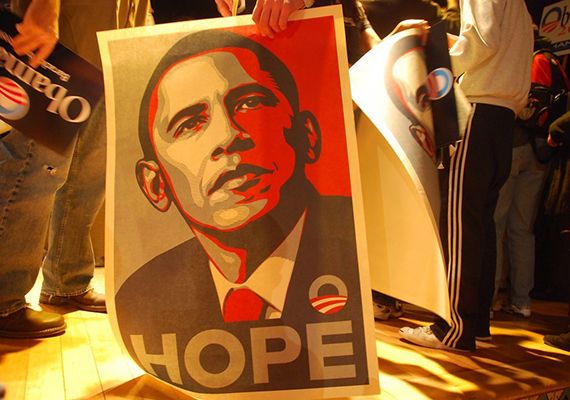
Hope
In Hope we see a close up of presidential candidate Barack Obama's face, as he looks into the distance in an optimistic and noble stance that is reminiscent of imagery of JFK. Rendered in the colors of the American flag, the image also reflects notions of patriotism. The work has become one of the best-known and most successful election posters in the Western World. Fairey created it from his own initiative after he was inspired by Obama's speech at the Democratic National Committee conference. At the time Fairey was protesting the Bush agenda and the Iraq War and when he learnt that Obama was supporting free healthcare and environmental protections, he decided it was time to promote something, rather than object to it. As Fairey remembers: "Obama was facing the challenge of being non-white. So my idea was to use red, white and blue to portray him as someone with vision in a stylized and idealized way." Originally he had used the word "progress" as a caption, but when the image began going viral, the campaign requested that he change it to "hope" and adopted it as an official image. Fairey added: "In the Bush years people felt hopeless, so it was aspirational."
Eventually, 300,000 posters and 500,000 Hope stickers were printed. Fairey didn't request payment for the work. He also put a free download on his website, so that people could print it out for themselves. Art writer Janelle Zara wrote that: "Hope, a gold version of which is now in the Museum of Modern Art's permanent collection, entered an art-historical canon of indelible political slogans, up there with Kruger's 'Your Body is a Battleground', and Jenny Holzer's 'Abuse of power comes as no surprise'." The piece catapulted Fairey into the mainstream, leading to claims from some quarters that he had "sold out."
Hand-finished collage, stencil and acrylic on paper
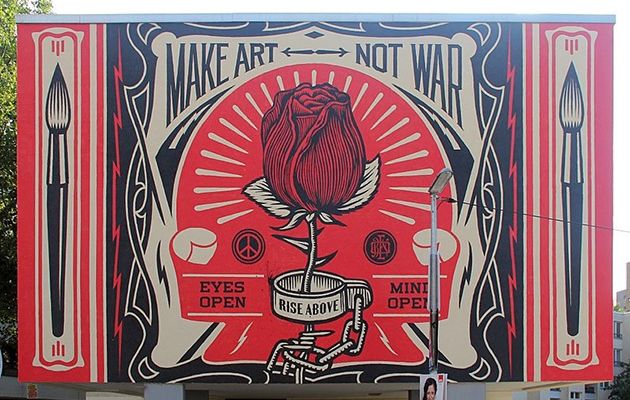
Make Art Not War
"Make Art Not War" is a slogan Fairey has used repeatedly in posters, prints and murals to promote an agenda of global peace. This large mural combines a number of Fairey's iconic designs; at the heart of which is a rose, the symbol of love, growing up towards the light despite being shackled in a cuff stating "rise above" - perhaps a nod to Fairey's many brushes with the law and authority. The edges of the mural are embellished with Art Nouveau decoration, and bordered by two stylized paintbrushes. The words "eyes open" and "mind open" also draw reference to his "obey" message, inviting the viewer to be aware of their surroundings and wider role in society. To the left of the rose is the ban the bomb logo used by the CND (Campaign for Nuclear Disarmament) and mirrored on the right are the letters of OBEY joined in an emblem.
References to propaganda art and Russian Constructivism are clear in the bold design, the red, black and white color scheme and the use of symbols, text and decoration. But it is also reminiscent of punk album covers and pop art - Fairey has noted Robert Rauscenberg and Jasper Johns as influences and again we see the red and black of Barbara Kruger's political art. Art professor Dr. Hwa Young Caruso explained: "Fairey's street art helped him to fulfill a personal dream of reconciling love and war. He tries to awaken the sleeping silent majority by questioning every aspect of authority. Individuals should empower themselves by adding their personal voices to the democratic process. Fairey has empowered himself and others through his expression, and his voice continues to develop." He reprised a similar theme to this in 2015 in the colors of the tricolor in opposition to the terror attacks in France.
Spray-painted mural - Berlin-Kreuzberg
Earth Crisis
Fairey was the first artist ever permitted to create an installation at the Eiffel Tower in Paris, and it was unveiled to time with the COP21 Climate Conference in the city. Fairey had been promoting a sustainability agenda since the 1990s when he began designing campaign material for influential environmental groups and this work marked a continuation of those themes. The eight-meter wide sphere hung from the second floor of the tower, and depicted images that promoted harmony along with others that showed the impact mankind was having on the earth. The floral motifs sent a message of unity and optimism, alongside an image of a woman shielding her eyes from the burning sun with a newspaper - a warning against apathy. Standing directly beneath, a viewer could look up to see a mandala, reminding them of their debt to future generations.
The installation departed from the reds, oranges and golds characteristic of Fairey's other work. Instead he chose a color palette of blue and aqua tones in a reminder that we need clean air, water and vegetation to sustain the planet. The globe's suspension represented the fragility of human life on the planet and the work was accompanied by a number of mixed media paintings on canvas and paper, prints, collectible globe sculptures, and books. Fairey said: "The installation, the murals, the fine art, and the prints - they are all different platforms to put across the message that we are facing an earth crisis. I think that art is a way to engage people. Art can initiate conversations when other media fails....I hope that it appeals visually and sparks the needed conversation about protecting our planet for future generations."
Installation - The Eiffel Tower, Paris
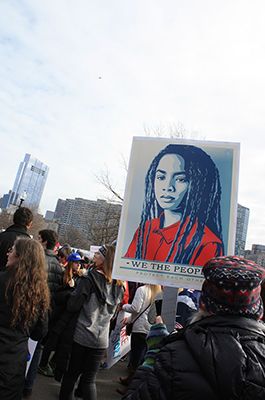
We The People
For Trump's inauguration in 2017, in an attempt to protest his xenophobic rhetoric, Fairey produced a number of posters alongside artists Ernesto Yerena and Jessica Sabogal depicting minority Americans. Depicting black, Latina, Muslim and Native American women, the images were reminiscent of the Hope poster in the stylized features, red, white and blue color scheme and messages of strength and optimism. Fairey has long used iconic images from Americana to question what it really means to be an American citizen, and his use of a woman in a hijab adorned with stars and stripes, is an extension of that, showing modern America as diverse and promoting a message of inclusivity.
The posters included the first three lines from the American Constitution, "We the people", along with post scripts "protect each other" and "defend dignity". The posters were printed in newspapers and made available on the Obey Giant website, where people could download them for free. (Banners were not allowed at the inauguration, but the posters fell within accepted size requirements.) They were also used at varying women's marches which were held at 600 locations across the world. Fairey said: "It's really about making sure that people remember that 'we the people' means everyone, it means all the people...[It's] just reminding people to find their common humanity, and look beyond maybe one narrow definition of what it means to be American."
Poster - col
Biography of Shepard Fairey
Childhood
Frank Shepard Fairey was born in conservative Charlestown Carolina, to Charlotte Fairey, an English teacher, and Strait Fairey, a doctor. Known as Shepard since childhood, he was artistic from an early age, but felt constrained by his conventional surroundings. He said: "My mum was head cheerleader my dad was captain of the football team. I went to a preppy school and I was unhappy but I didn't understand why - until I discovered skateboarding and punk rock which were these anti-conformist, anti-mainstream movements that gave me an outlet for my creativity that I never had."
He attended local private school Porter-Gaud where he found his friends: "We were not the super cool group and we were not the nerd group...What you were made fun of about was if you wore the wrong jeans. My parents always said 'we're not spending money on that type of stuff and if people are mean to you about it then they are not real friends'. I said: 'I know. I need all the help I can get to survive'. Because it was all preppy, spoiled, smart little fucks."
He was difficult to control as a teenager - as his mother noted, "he marched to a different drummer" - so when he decided he wanted to go to art school, his parents agreed. Overnight he went from "studying 14 minutes a day to working 14 hours a day". He graduated from the Idyllwild Arts Academy in Palm Springs in 1988 and earned a B.F.A in illustration from the Rhode Island School of Design in 1992. He supplemented his studies by designing and selling skateboards and T-shirts.
Early Training
While he was at RISD he began experimenting with sticker stencils, a move that would shape his career. He said: "Drawing wasn't culturally cool. There were no hip art galleries. Teenagers don't care about art galleries so making stencils and stickers was very liberating for me. I felt as if I was if not pushing back, I was at least making my own path - which felt like doing something." He took his stickers out in the middle of the night, pasting them over the signposts and walls of New York and Providence. After graduating, he struggled to make ends meet, with his parents "constantly on my back to get a real job". His stickers, however, started to gain him attention and he was inspired to set up his own screen-printing studio which became a success.
In 1995 he came up with the "Obey" slogan, which was inspired by anti-advertising B-movie They Live. It was designed to provoke people into questioning the way they acted, the assumptions they accepted and the way they spent their money. It has since become an iconic symbol of anti-conformity.
Mature Period
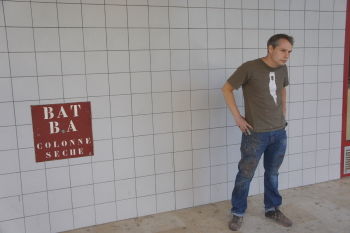
Fairey puts his determination and motivation down, in part, to the fact that he is living with type 1 diabetes. Predicting that he will die up to two decades before the average person, he spends more time thinking about the meaning of life. The disease has affected his sight, leaving him needing operations on his eyes and temporary blindness: "It makes me feel as if I'd better get busy" he said.
Fairey spent the late 1990s in San Diego where he, along with Dave Kinsey and Philip DeWolff, founded and ran a graphic design studio specializing in guerilla marketing. It was here that he met his wife Amanda. The pair bonded over a weird logo from a new fast food restaurant: "I fell in love right away". Together they travelled around the world, Amanda looking out for the police while Fairey "bombed" San Francisco, Tokyo, and Hong Kong with posters and stickers. It was a risky occupation, not only did he scale tall buildings and billboards to find the right location for his work, he was also arrested multiple times. He said: "Everyone thinks getting arrested is no big deal. Until it happens and then they realize what it's like." Fairey has listed being denied a drink, prevented from using the toilet, prohibited from making a phone call and having handcuffs put on too tight among his experiences. Most seriously, he has been denied his insulin while in custody.
In 2003, Fairey and his wife set up their own design agency, Studio Number One and in 2005 the couple had their first daughter, Vivien, and two years later, Madeleine. Fairey claimed the experience of having children made him examine the presidency they would grow up under and in 2008 he found mainstream success with the poster Hope, which he created for the Obama campaign. It has since been described as the most effective American election poster in history.
The following year he had his first solo museum show at Boston Institute of Contemporary Arts. As he was about to enter the preview of his show, however, he was arrested on two outstanding warrants for damage to property caused by his graffiti. Amanda described how heavy handed the event was: "I really thought maybe the cab driver had a brick of coke in the car." He said: "I went from having my first museum solo show, the inauguration, my original poster of Obama going into the National Portrait Gallery, to being arrested in Boston." He received two years' probation, after pleading guilty to one count of defacing property and two counts of wanton destruction of property, eleven other charges were dropped.
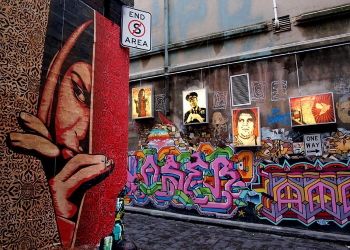
The arrest was compounded by the fact that Fairey was in dispute with the Associated Press over copyright at the time. He had created the image for the Hope poster from a photograph that he'd found online - stating that he had adapted it enough to constitute fair use of the copyrighted work. Associated Press and Mannie Garcia, the freelance photographer who took it, disagreed. The case was complicated by the fact that Fairey had allegedly confused which image he had used, and had subsequently deleted files on his computer in an attempt to cover his tracks. Whilst the initial case was settled out of court with the details undisclosed, Fairey found himself back in court in 2012 on charges of destroying and fabricating documents during the original legal battle. He pleaded guilty to criminal contempt and received a sentence of two years of probation, 300 hours of community service, and a fine of $25,000.
It was a difficult time for the artist and his young family,"dealing with the case in Boston was very stressful. I was on the verge of a nervous breakdown from that. Then I had the AP lawsuit...I felt overwhelmed." He continued that "It was a dark time for me. It was very, very, very stressful and depressing." Matters gradually improved and in 2010 art dealer and curator Jeffrey Deitch asked Fairey to present a show on America, featuring underground and political heroes of the time. Entitled May Day, when it opened on New York's Wooster Street, people queued around the block to get in.
Later Developments
Throughout his career, Fairey has been a committed activist; as well as protesting the Iraq War and supporting Occupy Wall Street, he has advocated gun control and more recently environmental protection. In 2012 he created a portrait of African American teenager Trayvon Martin, and he designed a T-shirt for Senator Bernie Sanders's 2016 Democratic presidential campaign.
In 2015, he produced a 3D installation on the Eiffel Tower during the Paris Climate Conference. The large globe was suspended between the first and second tiers of the tower. Fairey said: "I am the first artist in history to do it. That is really incredible for me. To have the entertainment value, the spectacle and serious content come together is rare. I was proud of it, and it was getting attention in a really amazing place. I think the idea that art can become a symbol or a starting point for a conversation, that is very valuable to me." This work placed Fairey in the same arena as Olafur Eliasson, Agnes Denes, and other artists that are foregrounding the vital issues of climate change in their work.
Fairey has donated proceeds from his artwork to campaigns including Black Lives Matter and the American Civil Liberties Union and he also produced three posters entitled We The People in opposition to the Trump campaign. Featuring minority women as their subjects, they were used in women's marches across the world. While Fairey was a strong supporter of Obama, he has shied away from addressing Trump's politics directly, who he describes as "the worst president the USA has ever seen". Instead, he uses his art to examine what he sees as the problem: "I am taking on the underlying issues, racism, sexism, xenophobia, environmental destruction, climate change. I am looking at Trump as a symptom but I would rather appeal to people in a way that doesn't make it about partisan politics, but rather which side of history do you want to be on. Pro-planet, pro-human, pro-equality, pro-justice."
Fairey's wide portfolio, however, has made him a controversial figure in certain circles. He has received criticism from some members of the urban art community for his commercial projects, which they believe are 'selling out'. On the other hand, he has been challenged for targeting public spaces with his campaigns. This resulted in a further legal dispute in 2018, when he was charged as part of Detroit Mayor Mike Duggan's aggressive crackdown on graffiti and unauthorized street art. The case later dismissed.
The Legacy of Shepard Fairey
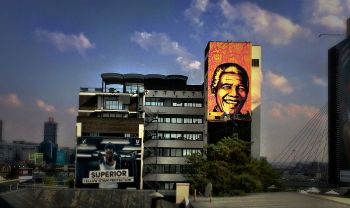
Fairey's Street Art adorns the walls of cities around the world, including Los Angeles, New York, London, Johannesburg, Berlin, Tokyo, and Hong Kong, but the very nature of it is that it is ephemeral. While posters and prints survive, his murals often disappear. He noted that: "I've been in street art 30 years. Most of my pieces don't last that long. As an artist you have to be comfortable with enjoying the process and not being precious about the product. I am always happy when something lasts but it's a world of many transgressions, the least of which is someone writing over my mural. People will tag me or write over my mural because they think I am too mainstream now, that I'm a sellout, or they know that my work will be photographed and it will get them attention. I consider myself an ally with all the other people doing things on the street."
Fairey has become one of the most influential Street Artists working today, and has been dubbed "this generation's Warhol". He was the subject of James Moll's film Obey Giant, has appeared in Banksy's film Exit Through the Gift Shop and took on a guest role in the Simpsons episode Exit Through the Kwik-E-Mart. In 2019 a retrospective of Fairey's work, Facing the Giant: 3 Decades of Dissent, was opened at the Over the Influence gallery in Los Angeles' Arts District. He has influenced a new generation of Public and Street Artists including Franky Aguilar, Jack Devereux and Hungry Castle. An unintended consequence of Fairey's work is that it has boosted property prices; an apartment in Costa Mesa, California sold for more than double average value in 2019 thanks to an enormous Fairey mural on its side.
Influences and Connections

-
![Banksy]() Banksy
Banksy -
![Barbara Kruger]() Barbara Kruger
Barbara Kruger -
![Marcel Duchamp]() Marcel Duchamp
Marcel Duchamp -
![Jasper Johns]() Jasper Johns
Jasper Johns - Space Invader
- D-Space
- Thierry Guetta
- Robbie Conal
-
![Banksy]() Banksy
Banksy - Franky Aguilar
- D-Space
- Robbie Conal
- Mear One
-
![Street and Graffiti Art]() Street and Graffiti Art
Street and Graffiti Art -
![Environmental Art]() Environmental Art
Environmental Art ![Activist Art]() Activist Art
Activist Art
 Ask The Art Story AI
Ask The Art Story AI